>>>Natures Of Universe<<<
Home Page › Forums › API Clubhouse › Interesting Shows/Websites/Book Previews › >>>Natures Of Universe<<<
- This topic is empty.
-
AuthorPosts
-
October 20, 2005 at 10:33 am #1010
Anonymous

When morning twilight came to the Paranal Observatory in Chile, astronomers Mark Neeser and Peter Barthel interrupted their search for faint quasars, billions of light-years away. And just for a moment, they used Very Large Telescopes at the European Southern Observatory to appreciate the beauty of the nearby Universe. One result was this stunning view of beautiful barred spiral galaxy NGC 613, a mere 65 million light-years away in the southern constellation Sculptor. Over 100 thousand light-years across, NGC 613 seems to have more than its fair share of spiral arms laced with cosmic dust clouds and bright star forming regions near the ends of a dominant central bar. Radio emission indicates the presence of a massive black hole at the center of NGC 613.
Credit: M. Neeser (Univ.-Sternwarte München), P. Barthel (Kapteyn Astron. Institute), H. Heyer, H. Boffin (ESO), ESO
October 20, 2005 at 10:36 am #5124Anonymous

Cat’s Eye
Staring across interstellar space, the alluring Cat’s Eye nebula lies three thousand light-years from Earth. A classic planetary nebula, the Cat’s Eye (NGC 6543) represents a final, brief yet glorious phase in the life of a sun-like star. This nebula’s dying central star may have produced the simple, outer pattern of dusty concentric shells by shrugging off outer layers in a series of regular convulsions. But the formation of the beautiful, more complex inner structures is not well understood. Seen so clearly in this sharp Hubble Space Telescope image, the truly cosmic eye is over half a light-year across. Of course, gazing into the Cat’s Eye, astronomers may well be seeing the fate of our sun, destined to enter its own planetary nebula phase of evolution … in about 5 billion years.
Credit: NASA, ESA, HEIC, and The Hubble Heritage Team (STScI / (AURA)
October 20, 2005 at 10:40 am #5125Anonymous

The Andromeda Galaxy in Infrared
What is the Andromeda galaxy really like? To find out, astronomers looked at our largest galactic neighbor in a different light: infrared. Astronomers trained the orbiting Spitzer Space Telescope at the Messier monster (M31) for over 18 hours, creating a mosaic that incorporated 11,000 separate exposures. The result, pictured above, shows M31 in greater infrared detail than ever before. Infrared light in this 24-micron color band is particularly sensitive to dust heated up by stars. Visible above are previously undiscovered features including intricate structure in the spiral arms, a spiral arc near the center, an off center ring of star formation, and an unusual hole in the galaxy’s disk. In contrast, the Andromeda galaxy appears much smoother in visible light and even ultraviolet light. Analyses and comparison of this image to other images will likely yield clues not only to the violent past of M31 but to our own Milky Way Galaxy as well.Credit : K. Gordon (U. Arizona), JPL-Caltech, NASA
October 20, 2005 at 10:47 am #5126Anonymous
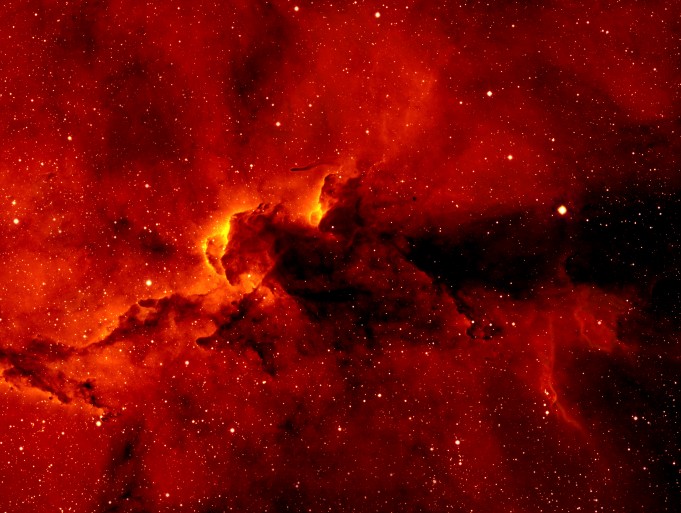
IC 1396 Close-Up
Clouds of glowing hydrogen gas mingle ominously with dark dust lanes in this close-up of IC 1396, an active star forming region some 2,000 light years away in the constellation Cepheus. In this and other similar emission nebulae, energetic ultraviolet light from a hot young star strips electrons from the surrounding hydrogen atoms. As the electrons and atoms recombine they emit longer wavelength, lower energy light in a well known characteristic pattern of bright spectral lines. At visible wavelengths, the strongest emission line in this pattern is in the red part of the spectrum and is known as “Hydrogen-alpha” or just H-alpha. Part of IPHAS, a survey of H-alpha emission in our Milky Way Galaxy, this image spans about 20 light-years and highlights bright, dense regions within IC 1396, likely sites where massive new stars are born.
Credit:Nick Wright (University College London), IPHAS Collaboration
October 20, 2005 at 6:46 pm #5127Anonymous
These are beautiful pictures….
October 20, 2005 at 7:14 pm #5128Anonymous
Very beautiful, and very enlightening 😀 We learn something new from here everyday! Thank you A3 😀
October 25, 2005 at 4:47 am #5129Anonymous
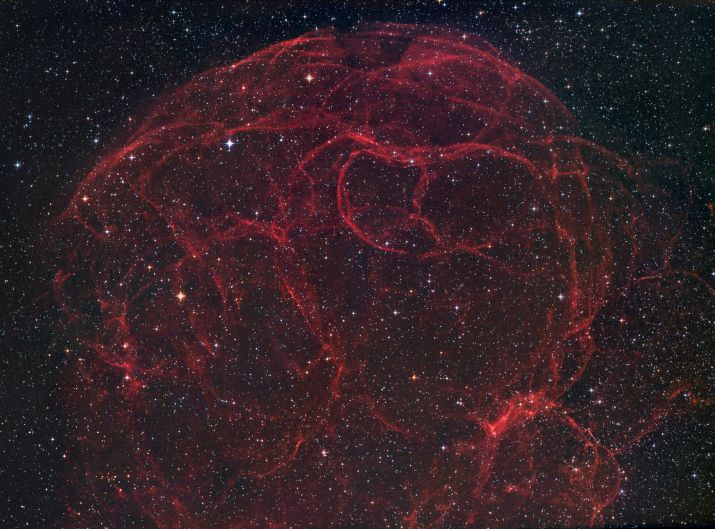
Simeis 147: Supernova Remnant
Explanation: It’s easy to get lost following the intricate filaments in this detailed image of faint supernova remnant Simeis 147. Seen towards the constellation Taurus it covers nearly 3 degrees (6 full moons) on the sky corresponding to a width of 150 light-years at the stellar debris cloud’s estimated distance of 3,000 light-years. The color composite image includes eight hours of exposure time with an H-alpha filter, transmiting only the light from recombining hydrogen atoms in the expanding nebulosity and tracing the regions of shocked, glowing gas. This supernova remnant has an apparent age of about 100,000 years – meaning light from the massive stellar explosion first reached Earth 100,000 years ago – but this expanding remnant is not the only aftermath. The cosmic catastrophe also left behind a spinning neutron star or pulsar, all that remains of the original star’s core.
Credit & Copyright: Robert Gendler
October 25, 2005 at 4:50 am #5130Anonymous

Planetary Nebula Mz3: The Ant Nebula
Explanation: Why isn’t this ant a big sphere? Planetary nebula Mz3 is being cast off by a star similar to our Sun that is, surely, round. Why then would the gas that is streaming away create an ant-shaped nebula that is distinctly not round? Clues might include the high 1000-kilometer per second speed of the expelled gas, the light-year long length of the structure, and the magnetism of the star visible above at the nebula’s center. One possible answer is that Mz3 is hiding a second, dimmer star that orbits close in to the bright star. A competing hypothesis holds that the central star’s own spin and magnetic field are channeling the gas. Since the central star appears to be so similar to our own Sun, astronomers hope that increased understanding of the history of this giant space ant can provide useful insight into the likely future of our own Sun and Earth.
Credit: R. Sahai (JPL) et al., Hubble Heritage Team, ESA, NASA
October 25, 2005 at 4:52 am #5131Anonymous
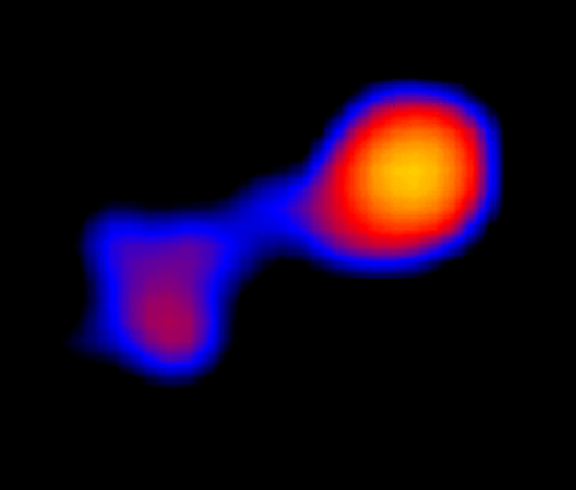
Mira: The Wonderful Star
Explanation: To seventeenth century astronomers, Omicron Ceti or Mira was known as a wonderful star – a star whose brightness could change dramatically in the course of about 11 months. Modern astronomers now recognize an entire class of long period Mira-type variables as cool, pulsating, red giant stars, 700 or so times the diameter of the Sun. Only 420 light-years away, red giant Mira (Mira A, right) itself co-orbits with a companion star, a small white dwarf (Mira B). Mira B is surround by a disk of material drawn from the pulsating giant and in such a double star system, the white dwarf star’s hot accretion disk is expected to produce some x-rays. But this sharp, false-color image from the Chandra Observatory also captures the cool giant star strongly flaring at x-ray energies, clearly separated from the x-ray emission of its companion’s accretion disk. Clicking the Chandra x-ray image of Mira will reveal an artist’s vision of this still wonderful interacting binary star system.
Credit:
X-ray Image: M. Karovska (Harvard-Smithsonian CfA) et al., CXC / NASA
Illustration: M.Weiss(CXC)[/b]October 25, 2005 at 4:54 am #5132Anonymous
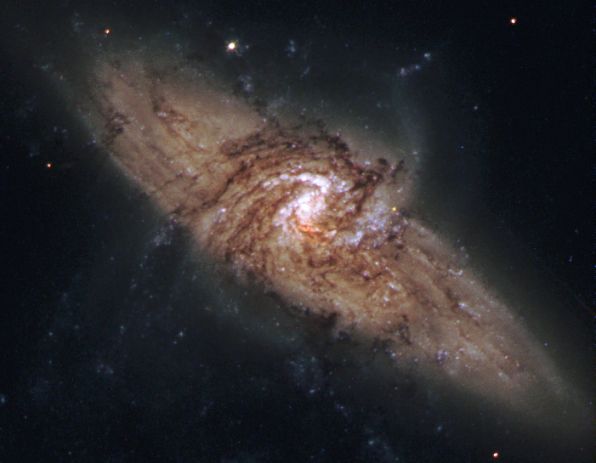
NGC 3314: When Galaxies Overlap
Explanation: NGC 3314 consists of two large spiral galaxies which just happen to almost exactly line-up. The foreground spiral is viewed nearly face-on, its pinwheel shape defined by young bright star clusters. But against the glow of the background galaxy, dark swirling lanes of interstellar dust are also seen to echo the face-on spiral’s structure. The dust lanes are surprisingly pervasive, and this remarkable pair of overlapping galaxies is one of a small number of systems in which absorption of visible light can be used to directly explore the distribution of dust in distant spirals. NGC 3314 is about 140 million light-years away in the multi-headed constellation Hydra. This color composite was constructed from Hubble Space Telescope images made in 1999 and 2000.
Credit: W. Keel & R. White (Univ. Alabama, Tuscaloosa), Hubble Heritage Team (STScI/ AURA), ESA, NASA
October 25, 2005 at 4:56 am #5133Anonymous
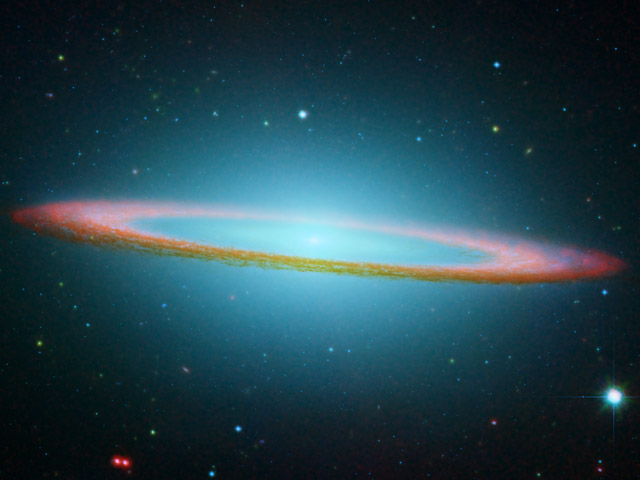
The Sombrero Galaxy in Infrared
Explanation: This floating ring is the size of a galaxy. In fact, it is part of the photogenic Sombrero Galaxy, one of the largest galaxies in the nearby Virgo Cluster of Galaxies. The dark band of dust that obscures the mid-section of the Sombrero Galaxy in optical light actually glows brightly in infrared light. The above image shows the infrared glow, recently recorded by the orbiting Spitzer Space Telescope, superposed in false-color on an existing image taken by NASA’s Hubble Space Telescope in optical light. The Sombrero Galaxy, also known as M104, spans about 50,000 light years across and lies 28 million light years away. M104 can be seen with a small telescope in the direction of the constellation of Virgo.
Credit: R. Kennicutt (Steward Obs.) et al., SSC, JPL, Caltech, NASA
October 25, 2005 at 4:58 am #5134Anonymous
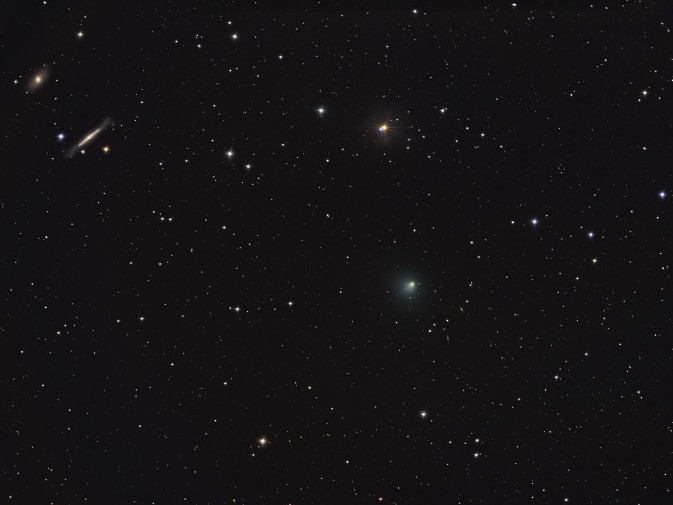
Stars, Galaxies, and Comet Tempel 1
Explanation: Faint comet Tempel 1 sports a fuzzy blue-tinted tail, just right of center in this lovely field of stars. Recorded on May 3rd slowly sweeping through the constellation Virgo, periodic comet Tempel 1 orbits the Sun once every 5.5 years. Also caught in the skyview are two galaxies at the upper left – NGC 4762 and NGC 4754 – both members of the large Virgo Cluster of galaxies. Classified as a lenticular galaxy, NGC 4762 presents an edge-on disk as a narrow gash of light while NGC 4754 is a football-shaped elliptical galaxy. Similar in apparent size, the galaxies and comet make for an intriguing visual comparison, but Tempel 1 is only about 3 light-minutes from planet Earth. The two Virgo cluster galaxies are 50 million light-years away. NASA’s Deep Impact spacecraft is scheduled to encounter Tempel 1 on July 4th, launching a probe to impact the comet’s nucleus.
Credit & Copyright: Johannes Schedler (Panther Observatory)
October 25, 2005 at 5:00 am #5135Anonymous
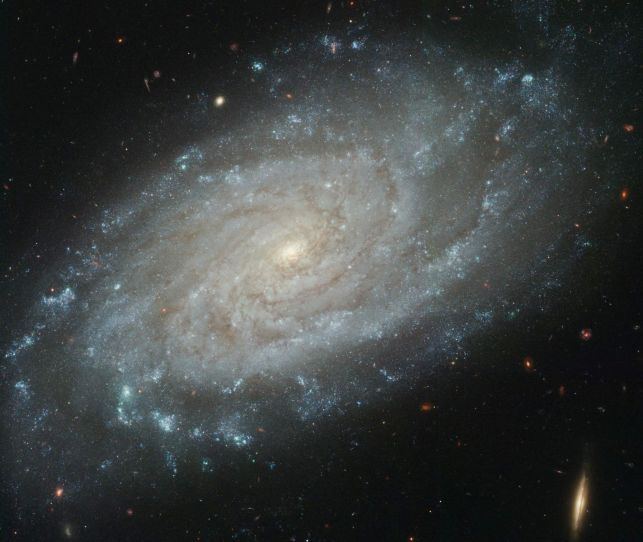
NGC 3370: A Sharper View
Explanation: Similar in size and grand design to our own Milky Way, spiral galaxy NGC 3370 lies about 100 million light-years away toward the constellation Leo. Recorded here in exquisite detail by the Hubble Space Telescope’s Advanced Camera for Surveys, the big, beautiful face-on spiral does steal the show, but the sharp image also reveals an impressive array of background galaxies in the field, strewn across the more distant Universe. Looking within NGC 3370, the image data has proved sharp enough to study individual pulsating stars known as Cepheids which can be used to accurately determine this galaxy’s distance. NGC 3370 was chosen for this study because in 1994 the spiral galaxy was also home to a well studied stellar explosion — a type Ia supernova. Combining the known distance to this standard candle supernova, based on the Cepheid measurements, with observations of supernovae at even greater distances, can reveal the size and expansion rate of the Universe itself.
Credit: Hubble Heritage Team, A. Riess (STScI) NASA
October 25, 2005 at 5:02 am #5136Anonymous
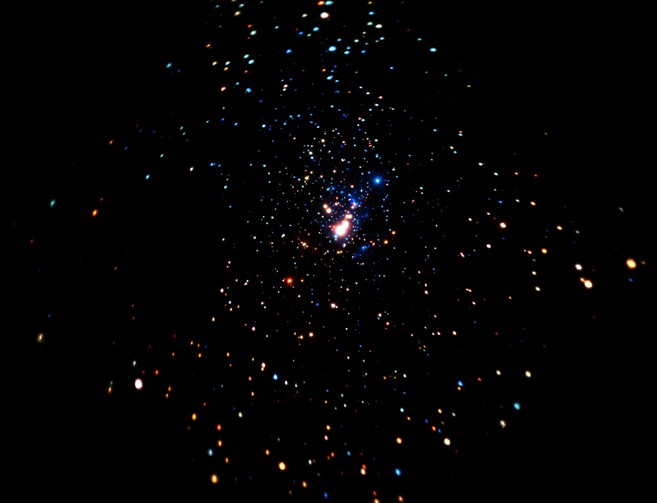
X-Ray Stars in the Orion Nebula
Explanation: When our middle-aged Sun was just a few million years old it was thousands of times brighter in x-rays. In fact, it was likely similar to some of the stars found in this false-color x-ray composite of the Orion Nebula region from the Chandra Observatory. The image is centered on bright stars of the nebula’s Trapezium star cluster, and while analyzing the Chandra data astronomers have now found examples of young, sun-like stars producing intense x-ray flares. It sounds dangerous, but the situation may actually favor the formation of hospitable planetary systems like our own. Energetic flares can produce turbulence in the planet-forming disks surrounding the stars – preventing rocky earth-like planets from spiraling uncomfortably close to and even falling into their active, young parent stars. About 1,500 light-years away, the Orion Nebula is the closest large stellar nursery. At that distance, this Chandra image spans about 10 light-years.
Credit: E.Feigelson & K.Getman (PSU) et al. CXC / NASA
October 25, 2005 at 5:03 am #5137Anonymous
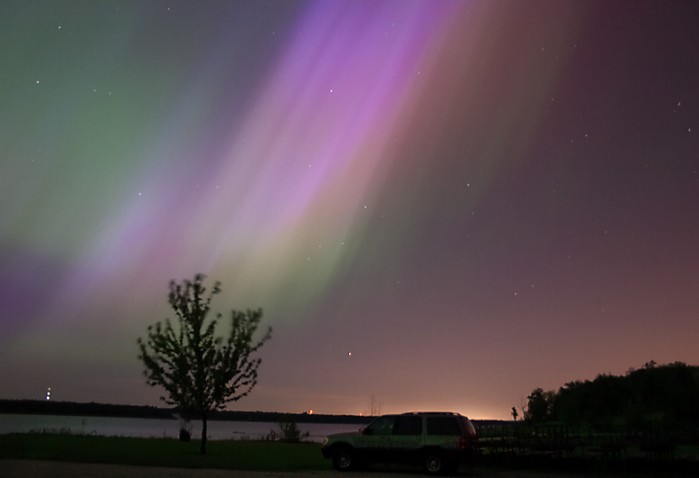
Aurora Iowa
Explanation: Early last Sunday morning stars were not the only lights in Iowa skies. The northern lights also shone from the heavens, extending across the midwestern USA and other locations not often graced with auroral displays. The wide-ranging auroral activity was triggered as a coronal mass ejection – an energetic cloud of particles blasted outward from the Sun a few days earlier – collided with planet Earth’s magnetosphere. Alerted to conditions ripe for aurora, photographer Stan Richard recorded this aparition over Saylorville Lake, near Des Moines. Bright planet Mars in the constellation Aquarius is above the horizon near the center of the eastward-looking view. While the colorful rays seem to end just above the water, they are actually at altitudes of 100 kilometers or more.
Credit & Copyright: Stan Richard
-
AuthorPosts
-
AuthorPosts
-
Anonymous- Offline

When morning twilight came to the Paranal Observatory in Chile, astronomers Mark Neeser and Peter Barthel interrupted their search for faint quasars, billions of light-years away. And just for a moment, they used Very Large Telescopes at the European Southern Observatory to appreciate the beauty of the nearby Universe. One result was this stunning view of beautiful barred spiral galaxy NGC 613, a mere 65 million light-years away in the southern constellation Sculptor. Over 100 thousand light-years across, NGC 613 seems to have more than its fair share of spiral arms laced with cosmic dust clouds and bright star forming regions near the ends of a dominant central bar. Radio emission indicates the presence of a massive black hole at the center of NGC 613.
Credit: M. Neeser (Univ.-Sternwarte München), P. Barthel (Kapteyn Astron. Institute), H. Heyer, H. Boffin (ESO), ESO
Anonymous- Offline

Cat’s Eye
Staring across interstellar space, the alluring Cat’s Eye nebula lies three thousand light-years from Earth. A classic planetary nebula, the Cat’s Eye (NGC 6543) represents a final, brief yet glorious phase in the life of a sun-like star. This nebula’s dying central star may have produced the simple, outer pattern of dusty concentric shells by shrugging off outer layers in a series of regular convulsions. But the formation of the beautiful, more complex inner structures is not well understood. Seen so clearly in this sharp Hubble Space Telescope image, the truly cosmic eye is over half a light-year across. Of course, gazing into the Cat’s Eye, astronomers may well be seeing the fate of our sun, destined to enter its own planetary nebula phase of evolution … in about 5 billion years.
Credit: NASA, ESA, HEIC, and The Hubble Heritage Team (STScI / (AURA)
Anonymous- Offline

The Andromeda Galaxy in Infrared
What is the Andromeda galaxy really like? To find out, astronomers looked at our largest galactic neighbor in a different light: infrared. Astronomers trained the orbiting Spitzer Space Telescope at the Messier monster (M31) for over 18 hours, creating a mosaic that incorporated 11,000 separate exposures. The result, pictured above, shows M31 in greater infrared detail than ever before. Infrared light in this 24-micron color band is particularly sensitive to dust heated up by stars. Visible above are previously undiscovered features including intricate structure in the spiral arms, a spiral arc near the center, an off center ring of star formation, and an unusual hole in the galaxy’s disk. In contrast, the Andromeda galaxy appears much smoother in visible light and even ultraviolet light. Analyses and comparison of this image to other images will likely yield clues not only to the violent past of M31 but to our own Milky Way Galaxy as well.Credit : K. Gordon (U. Arizona), JPL-Caltech, NASA
Anonymous- Offline

IC 1396 Close-Up
Clouds of glowing hydrogen gas mingle ominously with dark dust lanes in this close-up of IC 1396, an active star forming region some 2,000 light years away in the constellation Cepheus. In this and other similar emission nebulae, energetic ultraviolet light from a hot young star strips electrons from the surrounding hydrogen atoms. As the electrons and atoms recombine they emit longer wavelength, lower energy light in a well known characteristic pattern of bright spectral lines. At visible wavelengths, the strongest emission line in this pattern is in the red part of the spectrum and is known as “Hydrogen-alpha” or just H-alpha. Part of IPHAS, a survey of H-alpha emission in our Milky Way Galaxy, this image spans about 20 light-years and highlights bright, dense regions within IC 1396, likely sites where massive new stars are born.
Credit:Nick Wright (University College London), IPHAS Collaboration
Anonymous- Offline
These are beautiful pictures….
Anonymous- Offline
Very beautiful, and very enlightening 😀 We learn something new from here everyday! Thank you A3 😀
Anonymous- Offline

Simeis 147: Supernova Remnant
Explanation: It’s easy to get lost following the intricate filaments in this detailed image of faint supernova remnant Simeis 147. Seen towards the constellation Taurus it covers nearly 3 degrees (6 full moons) on the sky corresponding to a width of 150 light-years at the stellar debris cloud’s estimated distance of 3,000 light-years. The color composite image includes eight hours of exposure time with an H-alpha filter, transmiting only the light from recombining hydrogen atoms in the expanding nebulosity and tracing the regions of shocked, glowing gas. This supernova remnant has an apparent age of about 100,000 years – meaning light from the massive stellar explosion first reached Earth 100,000 years ago – but this expanding remnant is not the only aftermath. The cosmic catastrophe also left behind a spinning neutron star or pulsar, all that remains of the original star’s core.
Credit & Copyright: Robert Gendler
Anonymous- Offline

Planetary Nebula Mz3: The Ant Nebula
Explanation: Why isn’t this ant a big sphere? Planetary nebula Mz3 is being cast off by a star similar to our Sun that is, surely, round. Why then would the gas that is streaming away create an ant-shaped nebula that is distinctly not round? Clues might include the high 1000-kilometer per second speed of the expelled gas, the light-year long length of the structure, and the magnetism of the star visible above at the nebula’s center. One possible answer is that Mz3 is hiding a second, dimmer star that orbits close in to the bright star. A competing hypothesis holds that the central star’s own spin and magnetic field are channeling the gas. Since the central star appears to be so similar to our own Sun, astronomers hope that increased understanding of the history of this giant space ant can provide useful insight into the likely future of our own Sun and Earth.
Credit: R. Sahai (JPL) et al., Hubble Heritage Team, ESA, NASA
Anonymous- Offline

Mira: The Wonderful Star
Explanation: To seventeenth century astronomers, Omicron Ceti or Mira was known as a wonderful star – a star whose brightness could change dramatically in the course of about 11 months. Modern astronomers now recognize an entire class of long period Mira-type variables as cool, pulsating, red giant stars, 700 or so times the diameter of the Sun. Only 420 light-years away, red giant Mira (Mira A, right) itself co-orbits with a companion star, a small white dwarf (Mira B). Mira B is surround by a disk of material drawn from the pulsating giant and in such a double star system, the white dwarf star’s hot accretion disk is expected to produce some x-rays. But this sharp, false-color image from the Chandra Observatory also captures the cool giant star strongly flaring at x-ray energies, clearly separated from the x-ray emission of its companion’s accretion disk. Clicking the Chandra x-ray image of Mira will reveal an artist’s vision of this still wonderful interacting binary star system.
Credit:
X-ray Image: M. Karovska (Harvard-Smithsonian CfA) et al., CXC / NASA
Illustration: M.Weiss(CXC)[/b]
Anonymous- Offline

NGC 3314: When Galaxies Overlap
Explanation: NGC 3314 consists of two large spiral galaxies which just happen to almost exactly line-up. The foreground spiral is viewed nearly face-on, its pinwheel shape defined by young bright star clusters. But against the glow of the background galaxy, dark swirling lanes of interstellar dust are also seen to echo the face-on spiral’s structure. The dust lanes are surprisingly pervasive, and this remarkable pair of overlapping galaxies is one of a small number of systems in which absorption of visible light can be used to directly explore the distribution of dust in distant spirals. NGC 3314 is about 140 million light-years away in the multi-headed constellation Hydra. This color composite was constructed from Hubble Space Telescope images made in 1999 and 2000.
Credit: W. Keel & R. White (Univ. Alabama, Tuscaloosa), Hubble Heritage Team (STScI/ AURA), ESA, NASA
Anonymous- Offline

The Sombrero Galaxy in Infrared
Explanation: This floating ring is the size of a galaxy. In fact, it is part of the photogenic Sombrero Galaxy, one of the largest galaxies in the nearby Virgo Cluster of Galaxies. The dark band of dust that obscures the mid-section of the Sombrero Galaxy in optical light actually glows brightly in infrared light. The above image shows the infrared glow, recently recorded by the orbiting Spitzer Space Telescope, superposed in false-color on an existing image taken by NASA’s Hubble Space Telescope in optical light. The Sombrero Galaxy, also known as M104, spans about 50,000 light years across and lies 28 million light years away. M104 can be seen with a small telescope in the direction of the constellation of Virgo.
Credit: R. Kennicutt (Steward Obs.) et al., SSC, JPL, Caltech, NASA
Anonymous- Offline

Stars, Galaxies, and Comet Tempel 1
Explanation: Faint comet Tempel 1 sports a fuzzy blue-tinted tail, just right of center in this lovely field of stars. Recorded on May 3rd slowly sweeping through the constellation Virgo, periodic comet Tempel 1 orbits the Sun once every 5.5 years. Also caught in the skyview are two galaxies at the upper left – NGC 4762 and NGC 4754 – both members of the large Virgo Cluster of galaxies. Classified as a lenticular galaxy, NGC 4762 presents an edge-on disk as a narrow gash of light while NGC 4754 is a football-shaped elliptical galaxy. Similar in apparent size, the galaxies and comet make for an intriguing visual comparison, but Tempel 1 is only about 3 light-minutes from planet Earth. The two Virgo cluster galaxies are 50 million light-years away. NASA’s Deep Impact spacecraft is scheduled to encounter Tempel 1 on July 4th, launching a probe to impact the comet’s nucleus.
Credit & Copyright: Johannes Schedler (Panther Observatory)
Anonymous- Offline

NGC 3370: A Sharper View
Explanation: Similar in size and grand design to our own Milky Way, spiral galaxy NGC 3370 lies about 100 million light-years away toward the constellation Leo. Recorded here in exquisite detail by the Hubble Space Telescope’s Advanced Camera for Surveys, the big, beautiful face-on spiral does steal the show, but the sharp image also reveals an impressive array of background galaxies in the field, strewn across the more distant Universe. Looking within NGC 3370, the image data has proved sharp enough to study individual pulsating stars known as Cepheids which can be used to accurately determine this galaxy’s distance. NGC 3370 was chosen for this study because in 1994 the spiral galaxy was also home to a well studied stellar explosion — a type Ia supernova. Combining the known distance to this standard candle supernova, based on the Cepheid measurements, with observations of supernovae at even greater distances, can reveal the size and expansion rate of the Universe itself.
Credit: Hubble Heritage Team, A. Riess (STScI) NASA
Anonymous- Offline

X-Ray Stars in the Orion Nebula
Explanation: When our middle-aged Sun was just a few million years old it was thousands of times brighter in x-rays. In fact, it was likely similar to some of the stars found in this false-color x-ray composite of the Orion Nebula region from the Chandra Observatory. The image is centered on bright stars of the nebula’s Trapezium star cluster, and while analyzing the Chandra data astronomers have now found examples of young, sun-like stars producing intense x-ray flares. It sounds dangerous, but the situation may actually favor the formation of hospitable planetary systems like our own. Energetic flares can produce turbulence in the planet-forming disks surrounding the stars – preventing rocky earth-like planets from spiraling uncomfortably close to and even falling into their active, young parent stars. About 1,500 light-years away, the Orion Nebula is the closest large stellar nursery. At that distance, this Chandra image spans about 10 light-years.
Credit: E.Feigelson & K.Getman (PSU) et al. CXC / NASA
Anonymous- Offline

Aurora Iowa
Explanation: Early last Sunday morning stars were not the only lights in Iowa skies. The northern lights also shone from the heavens, extending across the midwestern USA and other locations not often graced with auroral displays. The wide-ranging auroral activity was triggered as a coronal mass ejection – an energetic cloud of particles blasted outward from the Sun a few days earlier – collided with planet Earth’s magnetosphere. Alerted to conditions ripe for aurora, photographer Stan Richard recorded this aparition over Saylorville Lake, near Des Moines. Bright planet Mars in the constellation Aquarius is above the horizon near the center of the eastward-looking view. While the colorful rays seem to end just above the water, they are actually at altitudes of 100 kilometers or more.
Credit & Copyright: Stan Richard
-
AuthorPosts
- You must be logged in to reply to this topic.
Bukit Brown Announcement
Dear Reader, For all Bukit Brown related matters and tours, please visit Bukit Brown's main website. API is part of the growing community fighting to save the resting place of our forefathers, from being destroyed by the present day government, through the construction of a 8 lane highway to replace the current Lornie Road. What do we know of the early Singaporeans who came, once loved, lived, died in, & died for this Country we called Singapore? Learn about them in Bukit Brown, and the Pride of being a Singaporean. Join our free Bukit Brown Tours and be a BROWNIE on our YouTube video. Join the Bukit Brown's community Facebook page.
Copyright © 2024 · All Rights Reserved · Asia Paranormal Investigators
Purpose Theme by Organic Themes · WordPress Hosting · RSS Feed · Log in